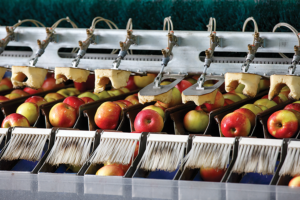Automation helping to revolutionize freshness in produce industy
With advancements in technology, the produce processing sector is undergoing a transformative journey, where human hands are increasingly being replaced by the precision and efficiency of automation.
Welcome to the era of fresh produce, redefined by smart machines and cutting-edge robotics.

According to Sustainability and Technology – The Future of Packaging and Processing, a report produced by The Association for Packaging and Processing Technologies (PMMI), technology is clearly playing a large role in all aspects of manufacturing, including training.
Initiatives cited by the 82% of respondents who experienced technology-enhanced training included: original equipment manufacturer/vendor-supported or -led training on new equipment; involving all employees in leading and managing continuous improvements; video training; software programs to test, record and store training data; virtual training systems for remote workers; cloud-based guides; digitized work instructions; and using visual elements.
Using automation to address labor force challenges and take over manual tasks has been a success, the survey found. Just 4% of those who replied to the PMMI survey said it has not been at all successful, compared with 88% who felt it has been successful and 8% who deemed it very successful.
The concept of automation is not entirely new to the produce industry. Historically, conveyor belts and basic machinery have been used to streamline certain aspects of the processing and packaging stages. However, the emergence of artificial intelligence, machine learning and robotics has ushered in a new era of automation, revolutionizing the way we handle, process and distribute fresh produce.
One of the key drivers behind the automation surge is the desire for enhanced efficiency and consistency. Hand-picking and manual sorting, while traditional and time-honored, can be slow and prone to human errors. Automation solutions offer speed and precision that not only reduce processing times but also ensure uniformity in product quality. This consistency translates to greater customer satisfaction and improved shelf life, preserving the freshness and taste of the produce from farm to table.

The heart of the automation revolution lies in smart sorting and grading systems. Using sophisticated sensors and computer vision technology, these systems can accurately assess the size, color, shape and defects of each fruit or vegetable passing through the assembly line. The data collected is then used to categorize the produce into different grades, optimizing packaging and distribution.
For instance, ripe fruits can be automatically separated from unripe ones, allowing for tailored packaging and distribution to various markets. Additionally, defective items can be identified and diverted for alternative uses, reducing waste and ensuring that only the best products reach consumers.
Automation’s impact extends beyond processing and into the fields themselves. Autonomous robots equipped with advanced sensors and cameras can now perform delicate harvesting tasks. These machines can identify ripe fruits and delicately pluck them from the plants, mimicking the precision of skilled human hands. This development addresses the ongoing challenge of labor shortages and ensures a timely harvest that minimizes losses.
Smart packaging solutions have also emerged, designed to prolong the shelf life and freshness of fruits and vegetables. Modified atmosphere packaging (MAP) involves altering the composition of the air inside the packaging to slow down the ripening process. Automation plays a crucial role in creating and maintaining these specialized atmospheres.
Beyond the immediate benefits of efficiency and consistency, automation in produce processing and packaging is contributing to broader sustainability goals. By streamlining operations and minimizing human handling, the industry can significantly reduce waste. Precise sorting and grading ensure that only the best products are sent to market, while automated packaging solutions minimize over-packaging and optimize space, resulting in reduced environmental impact.
Despite the advantages of automation, some challenges remain. Initial investment in cutting-edge technologies can be substantial, and some companies might be hesitant to embrace change due to concerns about job displacement. However, as the industry evolves, so do job roles. While certain repetitive tasks may be automated, new opportunities arise in managing, programming and maintaining the sophisticated systems.
Skilled workers are still essential in overseeing operations, making critical decisions, and ensuring that the machines operate at their full potential. Human expertise complements automation, providing a harmonious balance between the precision of technology and the finesse of human intuition.
Automation trends in the produce processing and packaging industry show no signs of slowing down. The smart machines of today will become even more efficient, versatile and sustainable. From farm to processing plant to supermarket, the fresh produce revolution is set to reshape the way we grow, handle and enjoy our fruits and vegetables.
Maria Ferrante is senior director, marketing and communications for PMMI and the producer of the PACK EXPO Portfolio of trade shows. Ferrante is an award-winning writer/editor who has been covering the packaging industry for more than 25 years.










